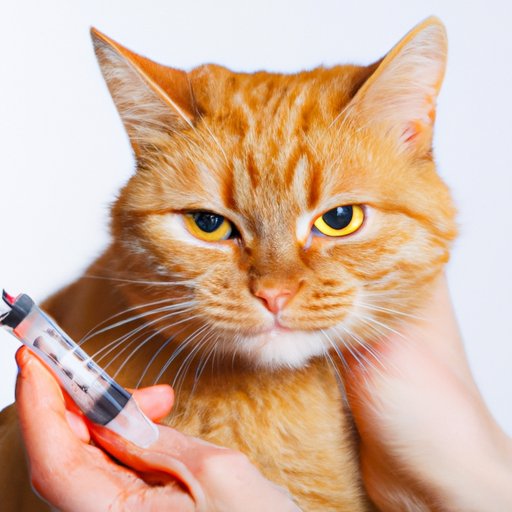
I. Introduction
Giving medicine to a cat can be a frustrating and difficult process for both the cat and their owner. Many cats will put up a struggle and refuse to take their medication, while others may experience adverse reactions. This article aims to provide cat owners with clear and straightforward instructions for administering medication in a stress-free manner.
II. Step-by-step instructions
The first step in administering medication to a cat is to determine the appropriate dosage and timing of the medication. It is important to follow your veterinarian’s instructions carefully and to never give a cat medication that has not been prescribed specifically for them.
When giving a cat medication in pill form, try wrapping the medication in a small amount of wet food or a pill pocket to mask the taste. Alternatively, you can place the pill directly at the back of the cat’s tongue to ensure that they swallow it.
If giving your cat a liquid medication, use a syringe to measure the correct dose and inject it into the side of their mouth. Be sure to avoid squirting the medication too quickly, as this can cause your cat to choke. It may help to tip the cat’s head back slightly so that the medication goes down more easily.
Topical medications, such as ointments or ear drops, should be applied directly to the affected area. Gently restrain your cat if necessary and use a clean finger or a cotton swab to apply the medication, being careful to follow any specific instructions provided by your veterinarian.
To make the process less stressful, try offering your cat treats or using calming pheromones to help them relax before and after medication administration.
III. Different medication forms
Cat medications can come in a variety of forms, including pills, liquids, topical ointments, and injections. When administering medication, it is important to follow the specific instructions provided by your veterinarian to ensure that your cat receives the correct dose at the appropriate time.
When giving pills, make sure to provide the right dosage and ensure that the medication is swallowed and not spat out. Use a pill splitter if needed to achieve the recommended dose.
Liquids are generally measured with a syringe provided by the veterinarian. Make sure to follow the instruction to avoid overdosing or under dosing the medication. For topical ointments, make sure the area is clean and apply directly, taking care not to rub anything into your cat’s eyes or ears without your vet’s directions.
IV. Tricks and treats
There are a variety of tricks and tactics that can make giving medication to cats a little easier. One popular tactic is to hide medication in a treat or in food the cat enjoys. You can also try offering a reward such as a favorite toy or extra playtime after medication administration to encourage good behavior.
It is important to never punish or force a cat to take medication, as this can cause undue stress and damage the bond between cat and owner.
V. Safety considerations
It is crucial to follow proper safety precautions when giving medication to a cat. Make sure to store medication out of reach of your cat and other animals, as many medications can be toxic to pets. Dispose of expired or unused medication properly by taking them to a veterinarian or medication disposal center.
Additionally, never give your cat medication intended for humans or other animals without specific instruction from your veterinarian. Some human and other animal medications can be lethal to cats.
VI. Case studies
Real-life stories of cat owners who have successfully given medication to their cats can offer helpful insights and tips for other cat owners. Examples of challenges include dealing with cats that do not like pills or liquid medication, as well as managing medication for elderly cats that require frequent dosing.
VII. Expert tips
Consulting with a veterinarian or animal health expert can provide valuable insights into effective medication administration practices. They can advise on how to administer medication safely and effectively and suggest specific strategies to use on cats that are particularly resistant to medication.
VIII. Conclusion
Administering medication to a cat can be a challenging task, but with the right strategies and techniques, it is possible to make the process smoother and less stressful for both cat and owner. By following the advice laid out in this article and consulting with a veterinarian if necessary, cat owners can successfully give medication to their furry friends without undue stress or risk.




